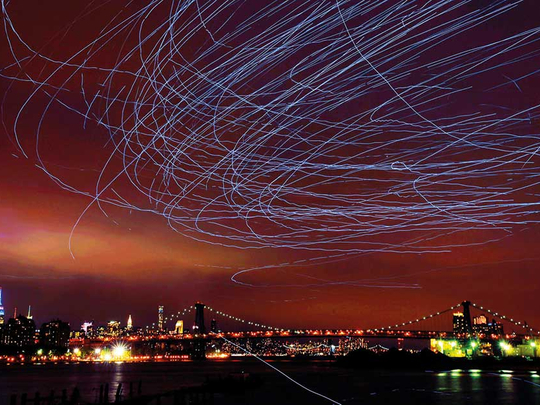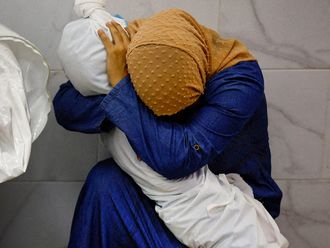
London: You can see them in the sky long before you get close, circling high above, wheeling and diving between each other, their wings flashing in the sunshine and making a faintly mechanical whirr each time they pass overhead. This vast flock of pigeons, flying over a disused golf course next to a sewage works on the eastern edge of London, has been assembled by Duke Riley, an American artist who has now spent months training these birds to re-enact a show that caused a storm when it hit the night skies over Brooklyn in 2016.
Though genetically similar to feral pigeons, these birds are specialist varieties that were selectively bred over thousands of years for their endurance and acrobatic abilities.
“Most are tipplers and rollers,” says Riley.
He’s a compact man with blue eyes, a square jaw and hands that look as though they are used to making things.
- Duke Riley, | American artist
“These are the birds people fly in New York, but they’re all English breeds originally.” There’s something knowingly old-fashioned about Riley. He wears overalls with the word “Duke” embroidered on the pocket and speaks in a hard Boston lilt.
In Europe, most fanciers, as pigeon-keepers are called, are interested in racing: they take their birds away from their lofts and time how long it takes them to fly back. But in the rest of the world, it’s more of a spectator sport. Fanciers will breed a flock (or “kit”) of birds, then train them using flags and whistles to fly tightly together over their loft. In competition, points are awarded for style and time in the air, or for attracting your opponents’ birds into your flock.
Riley grew up in Boston and now lives in Brooklyn, places that were once hotbeds of this kind of flying, which is now in decline in the west. He has been obsessed with pigeons ever since, as a boy, he found a lost homing pigeon and looked after it in his garage. “My mother told me to let it go,” he says, “so I did. But it kept coming back. I didn’t know anything about pigeons back then. I thought I was St Anthony.” Anthony is the patron saint of lost things, famous for his ability to speak to animals.
While at art school in Providence, Rhode Island, Riley lived in an old pigeon coop at the top of an apartment building, sharing it with feral city birds. Then he met a fancier who showed him what a well trained kit could do, and he quickly became hooked. “I lived there for four years,” he says, “and I became obsessed.” He has kept pigeons ever since, wherever he’s lived. “Sometimes I was just flying a couple of birds out the bathroom window or the fire escape, but I always maintained that interest.”
There are 1,500 pigeons in this loft at Thamesmead, and they require a lot of looking after. Riley and his team give them food and water twice a day, and clean out a wheelie bin’s worth of droppings every week. “It’s great fertiliser,” he says. Their health is carefully monitored, too. In the medical bay, eight birds are being treated for various ailments and injuries. They are cared for by the vet who looked after the owls on the set of the Harry Potter movies. Slivers of lemon are added to their drinking water. “Sometimes we give them garlic, too,” Riley says. “It’s good for their digestion.”
For three nights this week, Riley will stage performances of his celebrated work Fly By Night — an interspecies collaboration between the artist and his birds. Tiny LED lights will be attached to the feet of the pigeons, and they will then fly around the loft in front of an audience as the sun sets. When the piece was first performed, at a naval yard in Brooklyn, it was greeted with wild acclaim. In video footage of the event, the pigeons become specks of moving light, scoring abstract shapes on to the dusky sky in a hypnotic, gyrating, extraordinary dance.
Duke has brought the project to London as part of 14-18 NOW, an arts programme commemorating the centenary of the end of the first world war. Pigeons played an important role in the war: they were used on the front to deliver messages, many winning medals for their bravery. And the setting for the performance, in an area by the Thames once dominated by munitions factories, reflects that historic connection.
Riley’s work has often tackled “the space between the land and the water”. He describes the land as “a hyper-governed space, where there’s all these different systems and laws and societal structures that can be oppressive”. The water, meanwhile, is “the most ungoverned space, a piece of wilderness that still has its own rules that you can’t really control”. His birds fly between these two worlds.
Riley’s creations often invoke a playful folk aesthetic. He embroiders, makes scrimshaw (engravings on the tusks of sea mammals), and has a successful sideline as a tattoo artist. There is a heft to the things he makes, and a light-hearted subversiveness to the things he does. Once he created a popup bar on the Brooklyn waterfront using flotsam and jetsam collected from the Hudson River. A few years ago, he built a revolutionary-war replica submarine and sailed it towards the cruise ship Queen Mary II, before being arrested by river police as a potential terrorist.
The adventures are as important as the pieces he makes out of them. For his first pigeon work, Trading With the Enemy, he trained homing pigeons to fly to a loft in Key West, Florida, before taking them to Cuba, attaching cigars to their backs in tiny rucksacks, and releasing them. Eleven made it back wearing their contraband.
After he’s finished with them, the birds will be rehomed with local fanciers. Fly By Night is partly a way of drawing attention to a lost or at least dying art. Pigeon-flying has a long history as a working class, counter-intuitively urban pursuit, but fanciers are being driven out of cities by rising rents and increasing hostility to birds. “Gentrification is the culprit,” Riley says. “People are freaked out because they think pigeons are diseased, or because they misunderstand pigeon-flying and think it’s abusive. In my opinion, it’s the complete opposite.”
Does he think of his work as nostalgic? “I wouldn’t use the word nostalgia necessarily,” he says, “because I think it’s dangerous. But a lot of my projects are about empowering marginal communities. We’re living in a time when technology and nature are at war with each other on many levels, not least for our attention. I want to get people to stop and pay attention to the environment around them.”
He sees a correlation between the birds flying and a human drawing. “The movement that the bird makes, or when you have a whole kit of pigeons flying in a murmuration — no machine can replicate that.” In Syria, pigeon-flying is a popular pastime and Riley plans to next stage Fly By Night in a refugee camp there.
A few weeks after we meet, I return to Thamesmead to watch an evening rehearsal. It had been raining all day, and Riley was worried about the wind, which was blowing gustily. As dusk fell, he climbed to the roof of his loft. A bell rang and the pigeons took off in a huge clattering cloud. Some flew low over my head. Others climbed higher and higher into the sky until they were almost out of sight. At the centre of it all stood Riley, waving his flag and directing his flock like a manic conductor, his pigeons flying around him in the darkening sky.
Fly By Night is at East Thamesmead, London, from June 21 to 23.












